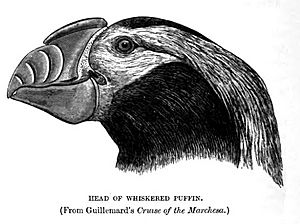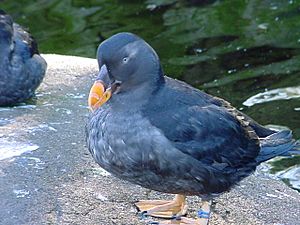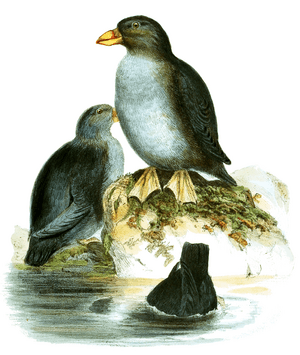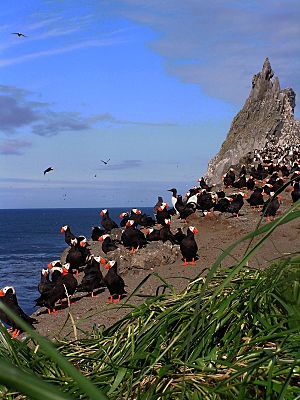Tufted puffin facts for kids
Quick facts for kids Tufted puffin |
|
|---|---|
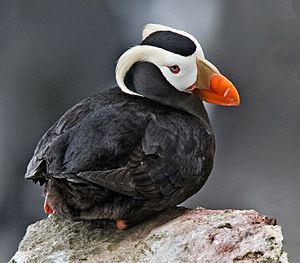 |
|
| Breeding adult, St. Paul Island, Alaska (USA) | |
| Conservation status | |
| Scientific classification | |
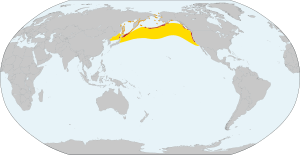 |
|
| Distribution map of the tufted puffin
extant (resident) extant (breeding visitor) extant (winter visitor) |
|
| Synonyms | |
|
Alca cirrhata Pallas, 1769 |
The tufted puffin (Fratercula cirrhata), also called the crested puffin, is a common medium-sized seabird. It belongs to the auk family (Alcidae). You can find these birds all across the North Pacific Ocean.
It is one of three types of puffin in the Fratercula group. You can easily spot it by its thick red bill and bright yellow tufts of feathers. These birds spend most of their lives far out at sea, in the open ocean.
Contents
What Does a Tufted Puffin Look Like?
Tufted puffins are about 35 cm (14 in) long. Their wingspan is similar to their body length. They weigh around 0.75 kilograms (1.6 lbs). This makes them the biggest of all the puffins.
Birds from the western Pacific are a bit larger than those from the eastern Pacific. Male puffins also tend to be slightly bigger than females.
Most of their body is black, with a white patch on their face. Like other puffins, they have a very thick bill. This bill is mostly red, with some yellow and sometimes green marks.
Their most special feature is their yellow tufts. These tufts appear every year when summer and the breeding season get close. Both male and female puffins grow them. Their feet turn bright red, and their face becomes bright white in summer. After the breeding season, the tufts fall off. Their feathers, beak, and legs also lose their bright colors.
Wings and Muscles
Like other alcids (birds in the auk family), their wings are quite short. These wings are perfect for diving and swimming underwater to catch food. However, they cannot glide in the air. Because of this, they have strong, dark chest muscles. These muscles are rich in a substance called myoglobin. This helps them beat their wings very fast and powerfully. They can keep this fast wing-beat going for a long time.
Young Tufted Puffins
Young tufted puffins look like adults in winter. But their chest is grey-brown, fading to white on their belly. Their bill is shallow and yellowish-brown. They look a lot like a rhinoceros auklet, but without the horn or other marks.
Where Do Tufted Puffins Live?
Tufted puffins gather in large groups to breed during the summer. These groups are called colonies. They live in places like British Columbia, southeastern Alaska, and the Aleutian Islands. You can also find them in Kamchatka, the Kuril Islands, and the Sea of Okhotsk.
They sometimes share their homes with horned puffins. However, tufted puffins usually live further east. They have been seen nesting as far south as the northern Channel Islands in California. But the last confirmed sighting there was in 1997.
Choosing a Home
Tufted puffins usually pick islands or cliffs that are hard for predators to reach. These spots are also close to good fishing areas. The cliffs must be high enough for them to fly off easily. The best places have steep slopes with soft soil and grass. This helps them dig their burrows.
During the winter, they spend almost all their time at sea. They travel across the North Pacific, going south to Japan and California.
How Tufted Puffins Behave
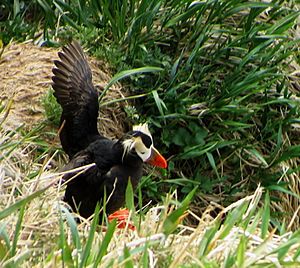
Reproduction and Life Cycle
Tufted puffins breed on isolated islands. More than 25,000 pairs have been counted in one colony off the coast of British Columbia. Their nest is usually a simple burrow. They dig it using their bill and feet. Sometimes, they use a crack between rocks instead. They line the nest well with plants and feathers.
To find a mate, they do special dances. They point their bills to the sky, strut around, and rub bills. They usually lay one egg in June. Both parents take turns sitting on the egg for about 45 days. The young birds, called fledglings, leave the nest when they are between 40 and 55 days old.
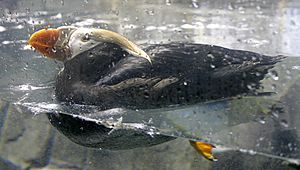
What Tufted Puffins Eat
Tufted puffins eat many different fish and small sea animals. They catch their food by diving from the surface of the water. What they eat changes a lot depending on their age and where they live.
Adult puffins mostly eat small sea animals like squid and krill. Young puffins near the coast mainly eat fish like rockfish and sandlance. Young puffins closer to the open ocean eat more small sea animals. They also eat some fish that live near the ocean bottom. This shows that puffins sometimes feed on the seafloor.
Their feeding areas can be far from their nesting spots. Puffins can hold many small fish in their bills. They carry these fish back to their chicks.
Predators and Dangers
Tufted puffins are hunted by birds like snowy owls, bald eagles, and peregrine falcons. Mammals like the Arctic fox also hunt them. Foxes seem to prefer puffins over other birds.
Puffins choose cliffs and islands without mammals to protect themselves. Laying eggs in burrows helps protect them from birds that steal eggs, like gulls and ravens.
Sadly, many puffins died near St. Paul Island, Alaska, between 2016 and 2017. Scientists believe this was due to changes in the ocean. These changes are linked to a warming climate.
Tufted Puffins and People
The Aleut people and the Ainu people (who called them Etupirka) in the North Pacific used to hunt tufted puffins. They hunted them for food and feathers. They used the skins to make warm coats called parkas. The soft tufts were used for decorations. Today, hunting tufted puffins is against the law or not allowed in most places where they live.
The tufted puffin is a well-known bird on the coast of the Russian Pacific. There, it is called toporok, which means "small axe." This name comes from the shape of its bill. Toporok is also the name of one of its main breeding spots. This spot is called Kamen Toporkov ("Tufted Puffin Rock") or Ostrov Toporkov ("Tufted Puffin Island"). It is a small island near Bering Island.
Protecting Tufted Puffins in Puget Sound
Many rules have been made to help protect fish and seabirds in Puget Sound. The Department of Natural Resources (DNR) in Washington State has created special water areas called aquatic reserves. These reserves are around Smith and Minor Islands.
Over 36,000 acre (146 km2) of shallow water and seafloor are part of this reserve. These islands provide important homes for many seabirds, including tufted puffins. They also help marine mammals. This area also has the largest kelp beds in all of Puget Sound.
Also, the Protection Island reserve is closed to the public. This helps marine birds breed safely. Protection Island has one of the last two nesting colonies of puffins in Puget Sound. About 70% of the tufted puffin population nests on this island.
See also
 In Spanish: Frailecillo coletudo para niños
In Spanish: Frailecillo coletudo para niños



